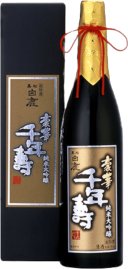Any price
Kitajima 'The Whale of Biwa Lake' Ginjo Sake
Kitajima Sake Brewery was established in 1805 and is one of Japan's oldest and most respected sake breweries, situated in the beautiful Shiga Prefecture near lake Biwa. Their highly crafted range is unique and distinctive with a palate that is much richer and fruitier than the average sake. Named after the great Biwa Lake in the Shiga prefecture, the largest lake in Japan, The Whale of Biwa Lake Sake is made from Koji Rice and is polished at 70%, pasteurised and non-filtered. This Junmai sake is rich, fruity and delicious. The distinctive richness of raw koji-rice lingers on the palate and gives way to notes of plum, banana and pear.
Taru Junmai Cedar Barrel Sake
A stunning sake distinguished by its maturation in Yoshino cedar barrel, distinguished by it maturation in Yoshino cedar barrels handmade in house by Kikkumasamune, it is dry and savoury with intense aromas of smoke and cedar with a balanced and silky palate. Drink this chilled or warm and match with spicy dishes or rich, full-flavoured cuisine.
Shirayuki Junmai Ginjo Akafuji Sake
A premium, dry sake produced with glossy rice polished to at least 50% of its original size. Light and complex, it has a fragrant nose of white chocolate, caramel and vanilla, leading to a fresh citrus fruit palate with a crisp, clean finish.
Shunnoten Junmai Ginjo Sake
The label of this super-premium sake features the warbler that sings in February when it is icy cold, a time when quality sake in Japan is produced. The nose sings of fruit and flower aromas while the palate is a complex fusion of sweet sour and a pleasant taste of Japanese plum on the finish.
Hiro Sake Junmai-Ginjo
Hiro Sake - The most awarded Sake in the world is now available here in Australia.Hiro is a constant Gold Medal winning Sake at the majority of the worlds major drinks competitions.The Blue is for chilled Sake which makes for great cocktails or just chilled straight, with or without ice
Hakutsuru Junmai Komedake no Maru Pack
The best value sake with smooth and roud mouthfeel followed by clear aftertaste. Its high quality and superior taste has made it Japan's best-selling sake brand. Either chilled or hot can be enjoyed.
Hakushika Junmai Pack Japanese Sake
Moderately dry with a full body, this premium junmai showcases fine Nishinomiya brewing standards. Conveniiently packaged for ease of use.
Hakushika Kuromatsu Junmai Japanese Sake
Standard but pleasant Junmai flavour. Gentle palate and light body. Mild acidity, calm bitterness and elegant sweetness.
Hakushika Chokara Japanese Junmai Sake Extra Dry
This is distrinctively dry sake with a crisp, refreshing finish and a pleasant compliment to bolder flavours. Well-balanced and smooth.
Hakushika Chotokusen Kuromatsu Goka Sennenju Junmai Daiginjo Japanese Sake
This is an elegant representation of Nishinomiya Sake at its finest. This sake has aromatic beginning and smooth finish full of finesse.











